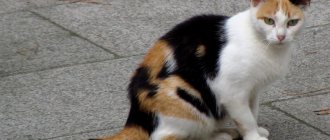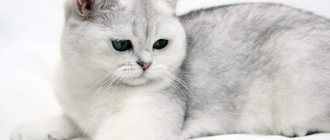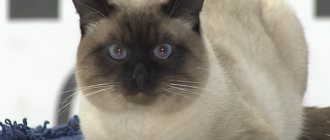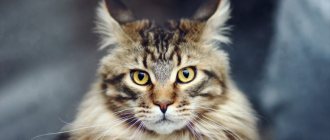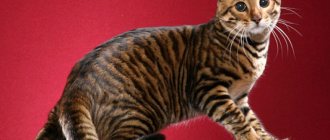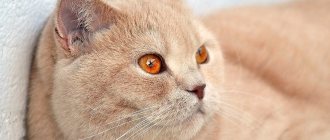The mutation that resulted in the birth of a kitten with a short tail formed the basis of many years of breeding work. This is how dozens of cat breeds were bred, called bobtails, from the English bob-tail, which translated means a short, stubby tail.
Thanks to their unusual appearance and character traits inherited from their ancestors, these felines found their admirers among breeders. Some varieties are recognized by international felinological associations, others are still in the process of registration.
For owners, a cat without a tail becomes an ordinary touching family pet, friend and companion.
Origin of breed characteristics
Cats with short tails have been known for centuries. Traditions and legends explain the presence of such a deviation in animals in different ways. In the biblical version, the cat that was late for the ark had its tail pressed against the door. An equally common misconception is that kittens are specifically subjected to surgery to obtain a fluffy pom-pom.
Genetics explained that the birth of individuals without the last vertebrae is associated with a mutation on several chromosomes. Due to the fact that most of the short-tailed breeds were bred on the islands in isolated communities, it was possible to quickly obtain numerous offspring of an unusual appearance.
Manx
Japanese branch
In ancient Japanese beliefs, there is a deity called Nekomata. He has the appearance of a cat with two tails and brings troubles, illnesses and suffering to people. When cats arrived in Japan along with merchant ships, the local population began to cut off the tails of their pets so as not to attract the attention of an evil spirit.
Naturally, selection preference was given to those animals whose tails were shorter than those of their relatives. Gradually, most of the cats on the island turned out to be the owners of a neat fluffy pom-pom.
Japanese Bobtail
All breeds with Japanese roots are called bobtails. In the land of the rising sun itself, they are called maneki-neko and are considered symbols of wealth and prosperity.
Since the economic and political isolation of the islands ended, representatives of unusual cats have spread throughout the world. Their genetic characteristics were used to breed tailless hybrids with other common breeds.
Read more in the article about Japanese bobtails.
British branch
Manx cats originated on the Isle of Man, located near Great Britain. The random mutation quickly spread and was fixed by additional selection. Unusual short-tailed cats became a curiosity and a local calling card and quickly spread from there throughout Europe and America. Externally, the animals are very similar to British Shorthairs. The appearance of rare furry offspring was received with great interest by breeders. Subsequently, a separate subspecies of long-haired Manx was even bred in Canada.
Manx
We recommend reading the article about the Manx breed.
There are other local branches that are of South American or Thai origin. The exterior of bobtails and manxes includes 4 different breed variations:
| Name | Length of the caudal process |
| Rampy | Completely absent |
| Reeser | 1-2 vertebrae |
| Stumpy | 4-8 links |
| Longs | A little shorter than usual |
Rampy
Reeser
Stumpy
Longs
qualities)
Due to the fact that the breeds in question have virtually no tail, they have well-developed other muscles. As for the very character of cats, they are distinguished by kindness and affection. Such individuals will become excellent companions for one person or perhaps a large family.
Short-tailed cats are quite playful, so you won’t feel sad. Individuals are quite indifferent to other animals in the house, so you can safely get someone else. Cats also have high intelligence. Thanks to this, you can safely train the animal. Rest assured, Murka will understand you perfectly.
Popular tailless breeds
The choice of a kitten is influenced not only by the presence of a cute feature in its appearance, but also by its character, intelligence, and price. Thus, the subspecies that are docile, stable and recognized by international felinological communities are becoming the most popular among owners.
American Bobtail
The progenitor of the breed is considered to be a kitten named Yodi. He was brought from an Indian reservation and, due to the fact that the gene for a short tail turned out to be dominant, they quickly received numerous offspring with the same feature.
For many years, breeders crossed Ragdolls, Manxes, Siamese and mongrel cats with Indian Bobtail offspring to create a unique breed. In the nineties of the twentieth century, it was recognized as an independent breed.
These are strong, muscular animals with dense thick fur. They have a friendly disposition, allowing pets to quickly learn and adapt to family life.
Also read the article about American Bobtails.
Japanese Bobtail
These are direct descendants of short-tailed cats bred in the land of the rising sun. It’s not without reason that miniature cats with shiny, smooth fur and a gentle character have become a symbol of well-being in Japanese families.
They are calm, clean, affectionate and become close friends to their owners and first helpers in the fight against stress.
Mekong Bobtail
The breed was bred in Russia. Kittens with unusual tails were brought from Siam (Thailand), with which our country has long-standing trade and economic ties. Breeders paid a lot of attention to preserving the exterior and original color of the animals.
Thanks to the efforts of breeders, Mekong cats are distinguished by bright blue eyes and a characteristic colorpoint color. Representatives of the breed do not have two similar tail shapes. They are almost as unique as fingerprints.
It differs from other breeds in its longer life expectancy. Animals are known to be 25 years old or more.
Miniature and cute pets will become faithful companions to their owners. They appreciate attention, affection and care.
Read the article about Mekong Bobtails.
Kurilian Bobtail
These cats were bred by crossing Japanese bobtails with wild inhabitants of the Kuril Islands of the Russian Far East. Fluffy, lush pom-pom tails and forest coloring, as well as piercing yellow or green eyes, have become a characteristic feature of the breed.
Breeders call them cats with the personality of a dog because of their incredible loyalty to their owner. They can defend it quite aggressively from strangers. Kurils are very active and curious, they love active games.
More about Kurilian Bobtails.
Karelian Bobtail
Representatives of the breed were the result of selection of short-tailed pets with a wild Norwegian cat. These are furry animals with an incredibly friendly and loving disposition.
At the moment, the subspecies is considered quite rare, although it has been known since the mid-eighties of the twentieth century. Karelians are very clean and hardly mark their territory.
Manx
This variety often produces kittens with the usual long tail. Most individuals have several vertebrae, and their complete absence is rare. Rampy cats are very rare. This is due not only to the low probability of their birth, but also to the fact that adult absolutely tailless individuals are often sterile.
Their few offspring are born with serious pathologies and rarely survive. Representatives of the breed have a calm character, they are clean and intelligent.
Cymric
These are long-haired descendants of short-tailed cats from the Isle of Man. Welsh cats do not have a tail at all, but they can give birth to completely normal kittens.
For several years, work has been underway to designate the Cymric as a separate breed, but for now official associations recognize them as long-haired Manx.
Read the article about the Cymrics.
Pixiebob
Cats of this breed look like miniature lynxes. Protective natural coloring, short tail, developed muscles and excellent hunting qualities make pixiebobs ideal partners for active games and walks.
Individuals are characterized by polydactyly - the appearance of additional fingers. Because of this feature, their paws look larger. They were bred in the USA, where they are considered national pride and heritage.
Read the article about pixiebobs.
Upbringing
American Bobtails have developed intelligence. They easily learn the rules of behavior in the house and quickly get used to using a tray and scratching post.
Kittens usually receive basic socialization in the breeder's home. In the new apartment, the baby needs to be shown a potty and be closely monitored in the first few days. If the short-tailed cat does not immediately remember where to relieve himself, he begins to worry, sit down, the cat must be carefully transferred to the tray. A smart kitten will quickly understand what is required of him. You cannot hit your pet for peeing in the wrong place. His negative emotions will be associated with the process of evacuation itself, and not with the place. The cat will begin to hide in the corners, and it will be much more difficult to train him to use the toilet.
You need to immediately wean your Bobtail away from playing with your hands. A grown large animal can unknowingly cause serious injury to a person. When the baby begins to bite or scratch, the game must be immediately interrupted and offered a special ball, fishing rod, teaser or mouse instead of fingers. An active Snow-Bob will be happy to engage in special “entertainment” activities and will not tear up furniture or books.
Thanks to their extraordinary mental abilities, Bobtails are easy to train and can master some simple commands. The main thing is to organize classes in the form of a game, then the Yankees will happily study, enjoying the additional attention from the owner.
If a child does something illegal, it is enough to reprimand him in a stern voice. American bobtails try not to disappoint their owners and have a great sense of intonation. When a young cat loses control of energy during play, it is permissible to spray it with a spray bottle. Representatives of this breed do not like water very much. He will associate pranks with unpleasant sensations. In general, Bobtails are very obedient; problems with their upbringing rarely arise.
Hybrid breeds
Sometimes, in order to obtain healthy and viable offspring, breeders resort to crossing short-tailed individuals with breeds that are suitable in appearance. Many of the resulting hybrids have not yet received official recognition, although they have characteristic features recorded in several generations.
Perhaps in the near future the right to be considered an independent breed will be given to:
- Toy Bob, a miniature blue-eyed cat bred in Russia, with a special Siamese coloring.
- The Oohee Bob is the result of crossing a Manx with a Siamese. They are characterized by color-point or bicolor colors. They inherited their character from their Asian ancestors. This is a self-sufficient, smart cat.
- Snow bob is a short-tailed subspecies with a snow-white color.
- Twisties, which are now being actively bred in the US state of Texas. The animals have short front legs and very long hind legs. According to the description, the cats are similar to tailless kangaroos.
- Oriental Bobtail, in which British breeders want to combine the exotic appearance of Orientals and the complete absence of tail vertebrae.
Japanese Bobtail
From the name of the breed of these animals it is immediately clear where they come from.
The main difference of this species is a very slender, beautifully built physique. Also, these cats are somewhat smaller in size than all the breeds described above. The eyes deserve special attention, since their specific shape and bright color are the main symbols of the breed.
The head of Japanese Bobtails is triangular in shape, with wide erect ears.
Such animals have a tail, but it is unusually small, sometimes even completely invisible. Their fur is smooth, fluffy and soft. These cats practically do not shed. As for colors, animals with three colors are most often found.
The peak demand for these animals occurred in the post-war years. And this species of animal was officially recorded in America in the 1960s.
Japanese Bobtail
Content Features
In general, caring for short-tailed cats is not very different from general grooming requirements. The only nuance is the need for washing with special products approximately once every two weeks. After water treatments, your pet’s fur coat should be thoroughly combed with special combs or a furminator.
We must remember that, regardless of breed, these are very active cats that need intense physical activity. They make ideal playmates for children.
Bobtails appreciate attention, are sociable and are ready to spend all their time in the company of their owners. They are rarely and reluctantly left on their own, they get bored and may even get sick.
Representatives of bob-tailed cats tend to have poor health. They need a balanced diet rich in micronutrients. It may take a long time to find the right diet. Read about how to choose the right diet for your cat on our portal.
It is important to maintain contact with the supervising veterinarian and conduct timely examinations and vaccinations.
If the animal is not suitable for further breeding, it must be sterilized.
Persian cat (small ears, erect)
To this day, debate about the origin of Persian cats continues. Some researchers believe that the ancestors of the breed were Asian desert and steppe cats, others attribute its relatives to the Pallas's cat, a fluffy wild cat with small ears. Despite the white spots in the pedigree, Persian cats managed to become the most popular decorative breed. Currently, they are so domesticated that they have completely lost the ability to catch mice and will not be able to survive in outdoor conditions.
Persian cats are very kind and loyal to their owner. They can follow him around for hours so that at the first opportunity they can climb onto his knees and sing their tender song. Persians are very patient with children and stoically tolerate all their games.
The disadvantage of the breed is the need for daily grooming. Without proper care, cat fur becomes matted and dirty. A more unpretentious alternative to classic Persians can be exotic Persians, whose stiffer and shorter coat resembles plush and requires much less careful grooming.
Mr. Cat recommends: the character of cats without a tail
Bobtails, Manx cats and their numerous descendants are very smart and curious, natural hunters, who love to climb and jump.
Their behavior can be compared with dogs. Short-tailed pets can spend the whole day with their owner, following on his heels. Cats need attention and communication; they always respond to calls, are empathic and attentive to the well-being and mood of family members. Pets get along well with children and other animals, but they show a genuine hunting interest in birds and rodents.
The animals are very clean and quickly get accustomed to the scratching post and tray. Even non-sterilized individuals rarely mark territory.
Pixiebob
- The tail part of the presented specimens is shortened and does not really stand out. It is difficult to confuse these animals with other individuals classified as felines. According to their external characteristics, they are similar to lynxes, and the absence of a tail is only touching.
- Pets are endowed with ears of the correct build, on which there are tassels of hairs at the tips. Yes, there are whiskers, which, again, bring these felines closer to lynxes. To have such a miracle in your home is real happiness.
- The cats are large in size; according to estimates, the body weight can be 9 kg. However, average individuals weigh approximately 7 kg. The body is well built and muscular, the spine is strong. The animal represents a hunter and a friendly family member in one package.
- Initially, representatives of the family were bred in the United States of America. After some time, they became more popular, and breeders began working on cats in Canada and other countries. These cats are characterized by an increased number of fingers, which is why they are called cats with mittens.
What to feed?
High-quality and balanced nutrition is the basis for good health and proper development of short-tailed cats. The animal is not picky about food. If desired, you can feed your cat ready-made factory-made dry or wet food of premium and superpremium classes. But the pet will not refuse natural food. The daily diet must include lean boiled meat, steamed sea fish, cottage cheese, kefir, fermented baked milk, and natural yogurt. Porridge will help provide the body with energy: rice, oatmeal, buckwheat. For normal digestion, it is useful to add vegetables to your diet, such as pumpkin, zucchini, and cauliflower.
Purchasing a kitten
There are few nurseries in Russia that breed Korats. Such animals can be found from private breeders, but most often these are breeders who deal with Russian blue cats or British blue cats, so the future buyer needs to be very vigilant when choosing a baby.
A breeder I know told me that in our city (Penza) there are no such cats at all. I found several advertisements with Korat kittens and decided to contact one of the numbers provided. During a phone conversation, the breeder explained that the cats look like Korats, but in fact they are the offspring of a Russian Blue cat. When I asked why she was misleading people, the woman explained that most potential buyers are not interested in purebreds. They say that people often look for beautiful cats that look like purebred cats, but they don’t even ask about the kittens’ parents.
Most often, kittens of Russian blue cats are passed off as Korats.
How to choose a Korat kitten
Any purebred kitten must meet the following criteria:
- beautiful and well-groomed appearance, its compliance with the breed;
- breed-specific behavior of the baby;
- availability of necessary documentation;
- suitable age.
First of all, the kitten should look healthy. His ears, eyes and nose must be clean, as well as his skin, without wounds, scratches or other damage to the skin. The tail should be smooth (exclude kinks, knots and other tail defects), the tummy should be rounded, but not hard. The animal should be moderately active, playful and friendly
If a small cat does not give in to hands, shows aggression, then, most likely, he does not receive enough attention from his mother or people, or is afraid
It is recommended to choose a kitten that will behave better and friendlier than the rest. I usually try to choose those babies that are easy to handle, but not intrusive
Pay attention to all the droppings. Some kittens will ask to be held and meow, and one kitten (usually the smallest) will sit in the corner and be silent.
Such quiet people grow up withdrawn. I try to choose “average kittens”. They grow up kind and moderately active.
Only healthy and well-groomed Korat kittens will grow into beautiful and kind pets.
No less important is the documentation that the breeder has. The kitten must have a veterinary passport
In addition to photographs and information about the breed, this document contains information about all medical operations performed (if any) and vaccinations. In addition, the baby must have a pedigree. Such paper is required if the breeder calls a blue kitten a purebred. It lists the cat's parents. This is the only way to confirm the purity of an animal.
Also, look at the baby’s fur. Russian kittens have a gray undercoat (thin downy hairs hidden in the main coat), but shorthaired kittens do not have such fluff. Part the fur with your fingers and look at the fibers. Their ends should be slightly lighter than the main part of the hair. Korat kittens also have a heart-shaped head almost from birth. The eyes of a silver cat will be gray-blue, but people usually don’t pay attention to their color at a young age. The paw pads should not be yellowish-gray like other gray cats. The tips of the ears should be rounded from birth.
When choosing a kitten, pay attention to the shape of the face and paws
The age of a kitten at which it is better to adopt it
The future owner of the Korat will want to take the pet when he is very young. There may be several reasons for this desire. Some people will want to see how the kitten grows and develops, while others will decide that moving the baby early will help him quickly adapt to new conditions. But in any case, it is not recommended to adopt a kitten until it is at least 3 months old.
There is a psychological connection between a cat and her kittens. If you tear your baby away too early, he may grow up unstable (aggressive or withdrawn). This will affect the behavior of the animal in adulthood. A cat that has experienced such severe stress at an early age can damage furniture, bite and scratch, go to the toilet in the corners of the apartment, etc.
Up to three months, kittens must be fed and raised by a mother cat.
An equally important reason why a cat can be adopted only after 3 months is vaccination. Between 2 and 3 months the animal will receive its first vaccinations, because by this age the immunity received from the mother will begin to decline.
To ensure your cat is healthy and survives in new, unusual conditions, adopt him no earlier than the recommended age.
Color
Each representative of the Mekong or Thai Bobtail breed has an acromelonic color, this is a type of color when the color merges closer to the limbs.
The colors of Mekong cats can be divided into several types:
- Seal-point – the general background is cream, the muzzle, paws and tail are black-brown in color;
- Red-point – the main coat color is white-peach, the tail, paws and muzzle are fiery red. This color is very rare;
- Chocolite-point – an unusual combination of snow-white fur all over the body with dark chocolate muzzles and toes;
- Blue-point – the main shade of the coat is silver, paws, muzzle and tail are bluish-pink;
- There may also be tortie-point colors (only cats can be colored this way) and tabby-point colors (a prerequisite is dark fur on the face in the shape of the letter “m”).
Castration and sterilization
Animals that do not meet standard breed characteristics and are unsuitable for breeding must be spayed or neutered to avoid unwanted matings.
At what age is it recommended to have surgery?
Castration or sterilization surgery is performed:
- for females - at 8–12 months (preferably before two years);
- for males - after 10 months.
Caring for your pet after surgery
Proper care of your pet after sterilization or castration surgery involves the following measures:
- immediately after the completion of surgical procedures, a special postoperative blanket and an “Elizabethan” collar are put on the animal to prevent sutures from licking;
- providing the pet with peace and quiet;
- daily treatment of postoperative sutures with disinfectant solutions (hydrogen peroxide, chlorhexidine, etc.);
- After the operation, the animal cannot be fed for 10–12 hours;
- limiting the pet's activity to avoid damage to the sutures.
After spaying or neutering surgery, it is necessary to put a post-operative blanket and collar on your pet.
All cats react differently to anesthesia. Some come to their senses almost immediately, while others sleep for a very long time. Our cat moved only along the wall for more than a day; she swayed in all directions. She started eating on the third day, but she returned to normal only a week later, when the blanket was removed.




